 Despite its utterly mystifying and goofy lenticular packaging, My Cat Is An Alien’s contribution to Staalplaat’s long-running studio session series is a very focused, formidable, and often incendiary affair. The Opalio brothers have a refreshingly unique and calculated aesthetic that more closely resembles an inspired evolution of free jazz than anything being done by their peers in the noise underground.
Despite its utterly mystifying and goofy lenticular packaging, My Cat Is An Alien’s contribution to Staalplaat’s long-running studio session series is a very focused, formidable, and often incendiary affair. The Opalio brothers have a refreshingly unique and calculated aesthetic that more closely resembles an inspired evolution of free jazz than anything being done by their peers in the noise underground.
My Cat Is An Alien’s story has an improbably fairy-tale-esque origin: in 1997, Maurizio and Roberto Opalio released their debut CD-R (limited to 30 copies) and sent one to Thurston Moore. Within two months, they were making their live debut as the opening act for Sonic Youth’s Italian tour. Since then, the duo have released an ungodly number of limited edition records and CD-Rs on their own Opax label, and made split albums with underground luminaries ranging from Loren Mazzacane Connors to Mats Gustafson to Jim O’Rourke. Notably, the Opax releases are generally housed in very arty handmade packaging, often featuring paintings by Roberto. With that historical precedent, it is difficult to process why this release looks like a gimmicky ‘80s baseball card and features a cartoon cat turning into an alien.
The exceedingly cryptic packaging gives no information about the music contained within, but Mort Aux Vaches consists of three lengthy works. The opening piece fades in with crackling vinyl, twinkling bells, and a slowly intensifying drone of gently shimmering guitars. Soon, some subtly burbling and spacey synthesizers begin to float pleasantly above the mix. However, that idyll is violently shattered by the harsh, almost animal wail of a treated guitar and the previously restrained spacey electronics increase in intensity before being ultimately engulfed in a rising surge of roaring static.
The second song is nearly half an hour long and effectively dominates the album. It begins with an incredibly dense maelstrom of chittering and oscillating sci-fi electronics augmented by cymbal flourishes and buried guitar moans. Slowly, the quivering chaos intensifies, the cymbals become more spirited, and deep tribal drums creep into the mix. Gradually the drums steal the focus, as a very insistent crash cymbal joins the pounding toms. Around the eight-minute mark, however, the propulsive tribalism disappears and the swirling electronic chaos asserts its supremacy once more. However, it is soon enhanced by some incredibly cathartic swooping guitar noises that sound like a family of dying elephants. Eventually, it all ebbs and a haunting ambient interlude of bells and a swelling, phase-shifting synthesizer wash emerges from the twittering, rippling electronic wreckage. That spooky foundation is maintained for an extremely long-time, but never becomes any less compelling, as an ever-shifting cloud of frothing improvised noise weirdness colors it. Shortly before the song ends, however, a mournful menagerie of strangled guitars appears and breaks the hypnotic spell.
Not unlike the first piece, the third song opens with pleasantly glistening guitar ambiance and a loop of spacey laser noises (the Opalio brothers are quite fond of incorporating toys into their work). The ambiance subtly throbs and wavers and increases in intensity until it is joined by a deep, rumbling percussion loop and feedback-heavy squalls of agonized guitar and gurgling, lurching electronics. It all coheres into a roaring, howling crescendo, then slowly fades away, leaving only a lonely ride cymbal in its wake.
There is nothing accidental or sloppy about these songs: Roberto and Mauricio make it abundantly clear that they know exactly what they are doing at all times and have recorded a decidedly complex, visceral, and textured set. I have not delved too deeply into MCIAA’s back catalog (being an MCIAA completist would result in my instant financial ruin), but it seems like this would be an excellent first album to get for anyone unfamiliar with their work. This is devastating and deliberate work- it is exceedingly rare for improvised music to work at such a gut-level.
Samples:
Read More

